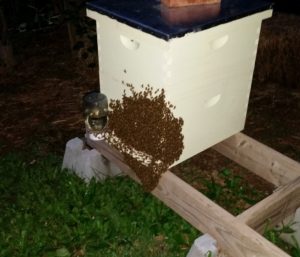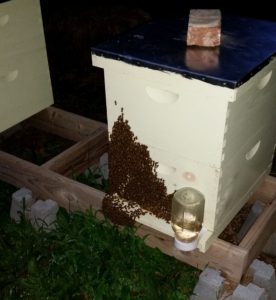Some of the links below are affiliate links, meaning, at no additional cost to you, I will earn a commission if you click through and make a purchase.
Last night, I picked up two baby hives (‘nucs’)of bees for the homestead. They’re both of the Russian bee species, which I’m hoping will help with mites, this year. This will be our third iteration with bees; the first year, one hive absconded, and the second “collapsed,” probably because of varroa mites. The second year, one collapsed due to disease load from mites, and the other was done in, or at least helped along, due to yellowjacket wasps.
Russian bees, however, are from the same area that the mites evolved from, and have developed a resistance. Mostly, it’s a form of “hygiene”–they clean the mites off of themselves, and chew off the legs, to keep the mites from re-attaching. (Yellowjackets can still be problematic, but if the bee population is decent, they’ll defend themselves.)
The nucleus hives come as a box–a little bigger than a shoebox–with five hive framesof honeycomb, a queen, about six thousand bees or so, and whatever they’ve managed to pack into the frames (mostly “brood”–baby bees). Normally, when installing the bees in their “permanent home,” you put them at least overnight where the hives will be, and open up the nuc entrance. Then you wait for a sunny point the next day, so the foragers will be out, and you swap the nuc box for a “normal” box in the same spot. The foragers won’t notice, when they get back–but they’ll have at least double the amount of room.
Last night, however, Mother Nature decided that it was time to move a little more firmly towards summer, and she lit into us with severe thunderstorms, as well as off-and-on rain all day. Most of the time, I’d leave the bees where they were, and wait for a sunnier day to move them. These boxes, however, were cardboard. Waxed cardboard, to be sure, but still, I didn’t want to risk the bees getting wet, and possibly deciding to abscond. (“Absconding” is similar to swarming–they all pack up with whatever honey they’ve got, and go looking for a new home.)
So, I waited until it was between sets of rain, and the sun tried to come out for a minute, then I got to deal with two very full boxes of bees. Both queens have been sighted, and they’ve both been laying a nice brood pattern, so there will be even more bees before too long. The “big” hives have even more honey (left from last year’s bees) and are almost completely drawn-out with comb, so they have lots of room to lay. I’ll give them a peek next weekend, and see how they’re doing. If it’s gangbusters, I’ll consider putting some honey supers on. We’re in this year’s flow, with black locust starting to bloom, and tulip poplars coming soon after.
Of course, they’re calling for thunderstorms and rain all week, which will limit the foraging. So, a little supplemental sugar syrup has been mixed up, and I’ve got plenty of sugar to make more, if needs be. With luck, it’ll be afternoon thunderstorms (typical for this time of year), and they’ll make it out to the trees in the mornings.
Given the rain, and the new accommodations, I didn’t get any pictures of them this weekend. The picture at the top of this post is from last year, at about this time. (Those are Italian bees, and as such are slightly larger and browner/yellower than the Russians.) But to tide us over until I can get some  pics, here are more from last year, as they “bearded” the fronts of the hives.
pics, here are more from last year, as they “bearded” the fronts of the hives.
 If any of you keep bees, I’d love to hear about them in the comments. What kind? How successful have you been with them? What tips do you have, that you could share with us?
If any of you keep bees, I’d love to hear about them in the comments. What kind? How successful have you been with them? What tips do you have, that you could share with us?

